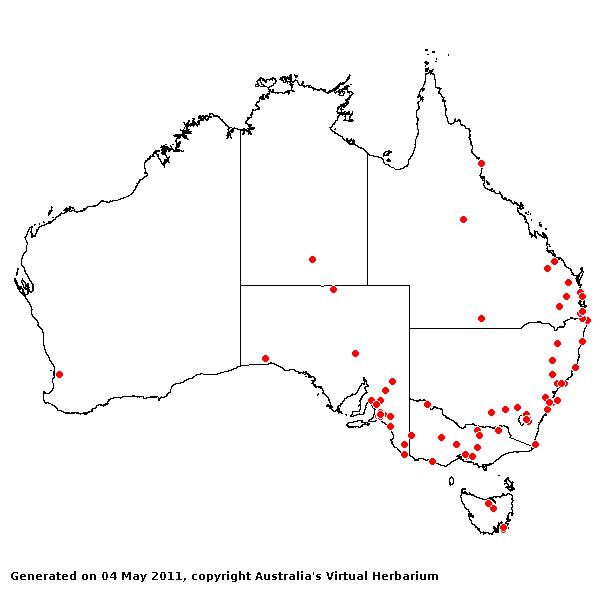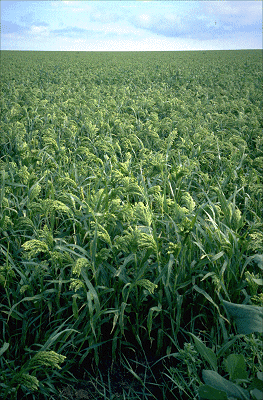Panicum miliaceum* L. Sp. Pl. 1:
58 (1753).
Classification. (GPWG 2001) : Subfamily
Panicoideae. Paniceae.
Type of Basionym or
Protologue Information: LT: India (LINN-80.49). LT designated by Sherif
& Siddiqi, Fl. Libya 145: 282 (1988).
Key references
(books and floras): [1952] C.A.Gardner, Flora of Western Australia 1
Gramineae (257), [2002] D.Sharp & B.K.Simon, AusGrass, Grasses of
Australia, [2006] J.Jessop, G.R.M.Dashorst, F.M.James, Grasses of South
Australia (463), [2008] S.W.L.Jacobs, R.D.B.Walley & D.J.B.Wheeler, Grasses
of New South Wales (316).
Illustrations:
[2006] J.Jessop, G.R.M.Dashorst, F.M.James, Grasses of South Australia (464, Fig. 397), [2008] S.W.L.Jacobs,
R.D.B.Whalley & D.J.B.Wheeler, Grasses of New South Wales, 4th edn
(316).
Habit. Annual.
Rhizomes absent. Stolons absent. Culms erect or geniculately ascending or
decumbent, 20–120 cm tall, 4–8 -noded. Mid-culm internodes glabrous or
pubescent or hispid. Mid-culm nodes glabrous or pubescent or bearded. Lateral
branches sparsely branched. Leaf-sheaths hairy. Leaf-sheath auricles absent.
Ligule a fringed membrane or a fringe of hairs, a ciliate membrane, 1.5–3 mm
long. Leaf-blades linear, 10–30 cm long, 6–15(–20) mm wide. Leaf-blade surface
scabrous, glabrous or indumented.
Inflorescence.
Inflorescence compound, a panicle. Panicle obovate, 5–25 cm long, evenly
furnished or with spikelets clustered towards branch tips.
Spikelets.
Spikelets pedicelled. Fertile spikelets 2-flowered, the lower floret barren
(rarely male), the upper fertile, comprising 1 basal sterile florets,
comprising 1 fertile floret(s), without rachilla extension, elliptic or ovate,
dorsally compressed, 4–5.5 mm long. Rhachilla internodes elongated between
glumes.
Glumes. Glumes
similar, thinner than fertile lemma. Lower glume ovate, membranous, without
keels, 5–7 -nerved. Lower glume apex muticous. Upper glume elliptic or ovate,
3.8–5.3 mm long, membranous, without keels, 7–13 -nerved. Florets. Basal
sterile florets 1, barren, with palea or without significant palea. Lemma of
lower sterile floret 100 % of length of spikelet, membranous, 7–11 -nerved,
muticous.
Fertile lemma 3–4.5 mm
long, without keel. Lemma apex muticous.
Continental
Distribution: Europe, Africa, Temperate Asia, Tropical Asia, Australasia,
Pacific, North America, and South America.
Australian
Distribution: Western Australia, South Australia, Queensland, New South
Wales, Victoria, Tasmania.
Western Australia:
Drummond, Dale, Warren, Avon. South Australia: Eastern, Northern Lofty,
Murray, Southern Lofty, South-eastern. Queensland: Mitchell, Moreton,
Port Curtis, Warrego, Wide Bay, Darling Downs. New South Wales: North
Coast, Central Coast, Central Tablelands, Southern Tablelands, North-Western
Slopes, Central-Western Slopes, South-Western Slopes, South-Western Plains,
North Far Western Plains, South Far Western Plains. Tasmania: No region
given.
Notes.
Introduced. Native to Asia and Europe where the grain is used for human
consumption. In tropical and subtropical wet sclerophyll forests, dry
sclerophyll forests, Brigalow forests, tropical and subtropical sub-humid
woodlands, temperate sub-humid woodlands, and eucalypt shrublands. Widely
introduced and planted as a forage species. Frequently escapes in temperate
regions and occurs as a weed in disturbed habitats. Flowers Jan.-May.




